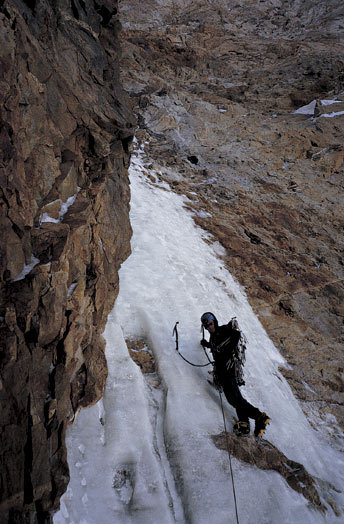
Kelly Cordes on the first enchainment of A la Recherche du Temps Perdu (ED+, 800m, Marsigny-Parkin, 1994) and the Ferrari West Face (ED+, 1000m, Chiapi-Conti-Ferrari-Negri, 1974). Cordes and Colin Haley managed the linkup (AI5 M5, 1400m) in two blocks over a forty-eight hour push, with Cordes leading Temps Perdu to the Col of Hope and Haley taking the Ferrari route to the summit. [Photo] Colin Haley
In 1994, Francois Marsigny and Andy Parkin climbed A la Recherche du Temps Perdu (ED+: 90 degrees, 800m) on the south flank of Cerro Torre (3102m) to the Col of Hope. Since then, at least two parties had climbed their line to or above the Col of Hope, but to our knowledge no one had yet made an integral ascent from this route to Cerro Torre’s summit. In mid-December Kelly Cordes and I hoped to do so, by completing a linkup of the Marsigny-Parkin and the Ferrari West Face route (AI5), which a team of Italy’s Lecco Spiders established in 1974 for the first true ascent of the mountain.
After three weeks of waiting, a perfect four-day weather window arrived in early January, and we hiked up from Campo Bridwell to our gear cache at the Niponino bivouac. At 5:30 a.m., January 5, we started climbing the 800 meters to the Col of Hope in five long simul-pitches and then stopped on a snow mushroom just above the col at 1:30 p.m. to brew and rest. We divided the climb into two massive lead blocks; Kelly led all of the Marsigny-Parkin and I led all of the West Face. We found the Marsigny-Parkin relatively moderate (ca. WI4 M5) but very sustained with almost no low-angle terrain. A couple of hours later we commenced up the remaining 600 meters of the West Face, simulclimbing through the right-hand side of The Helmet. The mixed pitches went easily, and we began the headwall pitch (AI5) at 9:30 p.m. and finished it in the dark. We hauled our packs on the headwall pitch, and I made a short pendulum on an ice screw after realizing I’d chosen the wrong groove.
Above the headwall we chopped a small ice nook and shivered in it for several hours, and then at first light headed up the three mushrooms of the summit ridge. The first two went easily, since natural ice tunnels had formed through their bellies, but the third provided the crux of our climb: vertical and then slightly overhanging snow. The rope running through a gigantic V-thread provided the only decent protection–a result of me tunneling inside the rime for about three meters. Two nerve-wracking aid moves off pickets allowed access to a finishing ice tunnel and the small summit plateau. The summit mushroom itself was easy; at about 1:30 p.m. we reached the top of a mountain I’d been dreaming of climbing since I was twelve years old.
Just before headlamps were necessary, we finished the last rappel on the Compressor Route and stumbled back into Niponino, exactly two days after our departure. Albeit with some objective hazard, our linkup formed a natural and easily accessible alternative to the bolt ladders of the Compressor Route.
–Colin Haley, Seattle, Washington